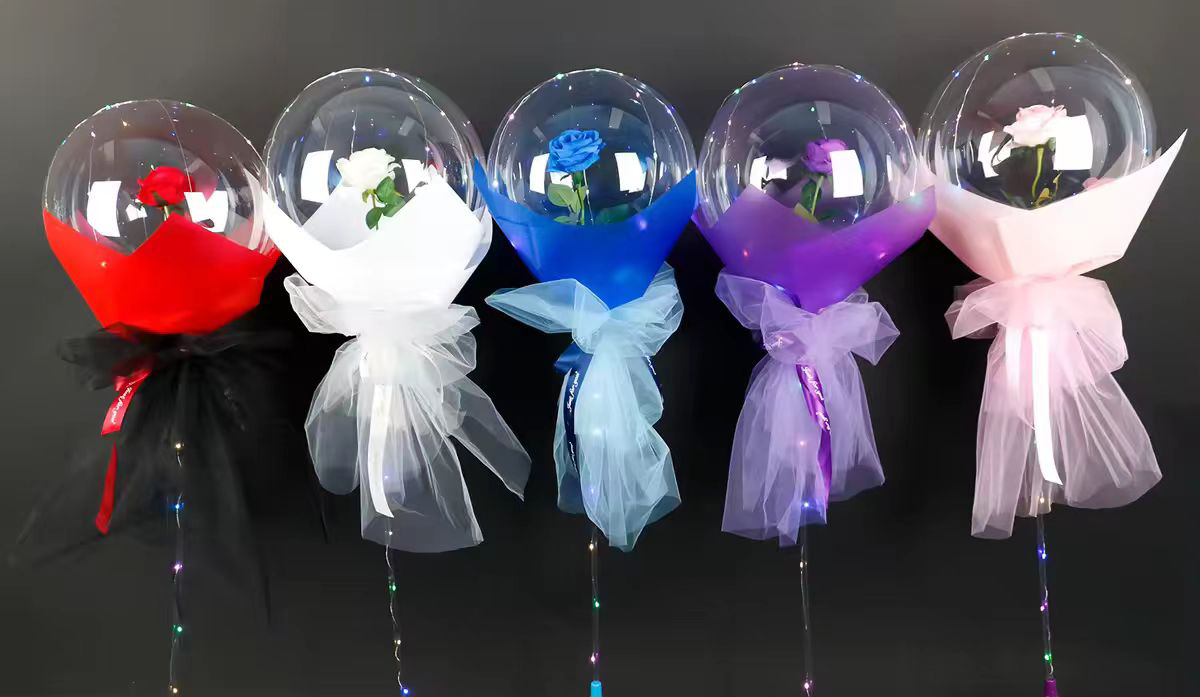Are Bobo Balloons Environmentally Friendly?
2025-01-24
Because of their gorgeous, whimsical designs, bobo balloons have quickly become popular and bring a distinctive flavor to special occasions, weddings, and celebrations. These balloons are frequently filled with feathers, confetti, or LED lights and are covered in a clear, long-lasting material that is eye-catching and ideal for decoration. But like many items, it's crucial to think about how they will affect the environment. You might be wondering if Bobo balloons are environmentally benign in light of the growing worries about sustainability and pollution.

1. Material Considerations: PVC vs. Latex
Bobo balloons are typically made from PVC (Polyvinyl Chloride), a synthetic plastic material known for its durability and flexibility. Unlike traditional latex balloons, PVC balloons are less prone to popping and deflating, which may seem like a bonus in terms of their longevity. However, PVC has a more concerning environmental profile compared to latex.
- PVC is not biodegradable, meaning it doesn’t break down naturally over time. If Bobo balloons are not disposed of properly, they can contribute to long-term pollution. The manufacturing process of PVC also has its environmental costs, as it often involves the use of toxic chemicals that can harm ecosystems.
- Latex balloons, which are sometimes used in alternative balloon options, are made from natural rubber and are biodegradable. While latex balloons decompose much faster than PVC, they still pose risks to wildlife, particularly in marine environments where they can be mistaken for food by sea creatures.
2. Environmental Impact of Balloon Disposal
Improper disposal of Bobo balloons can lead to significant environmental harm. Since PVC balloons do not biodegrade easily, if left in nature, they can persist for years, taking up space in landfills and potentially harming animals. Additionally, balloons that are released into the air pose a particular danger. As they deflate and descend, they can land in bodies of water, forests, or open fields, creating hazards for wildlife that may ingest or become entangled in the debris.
3. Sustainability of Balloon Filling
Bobo balloons can be inflated with helium or air, and the type of gas used also has an environmental impact:
- Helium: Helium is a non-toxic, inert gas, but it is a finite resource that is becoming increasingly scarce. It is often sourced from natural gas extraction processes, which contribute to carbon emissions and environmental degradation. Overuse of helium, particularly in balloons, may exacerbate shortages, affecting its availability for critical applications in medicine and science.
- Air: Air-filled Bobo balloons, while not causing helium depletion, still require energy for inflating. Depending on how the air is pumped into the balloons (whether manually or using electrical devices), there may be an energy footprint involved.
4. Is There an Eco-Friendly Alternative?
Some balloon manufacturers are moving toward more sustainable options, including biodegradable balloons made from plant-based materials. These alternatives are designed to break down more quickly in natural environments and pose less of a threat to wildlife. However, PVC Bobo balloons currently remain a popular choice due to their durability and aesthetic appeal, and options for more eco-friendly Bobo balloons are still limited.
5. Ways to Make Bobo Balloons More Sustainable
If you are set on using Bobo balloons for your event but want to reduce their environmental impact, consider the following tips:
- Avoid releasing balloons outdoors: The best way to prevent environmental damage is by ensuring that balloons do not end up in nature. Releasing balloons into the air is harmful and unnecessary. Instead, keep balloons confined to event spaces and dispose of them responsibly after use.
- Use air instead of helium: If you don’t need the balloons to float, consider using air instead of helium. Air-filled Bobo balloons last longer and do not contribute to helium depletion.
- Recycle and repurpose: After the event, try to recycle the balloons or repurpose them for another occasion. PVC balloons can be difficult to recycle in some areas, so check with your local recycling facilities to see if they accept PVC materials.
- Choose eco-friendly alternatives: Look for balloon alternatives made from biodegradable materials or explore eco-friendly Bobo balloon options as they become available in the market.
Conclusion
There are environmental problems with Bobo balloons, despite their undeniable beauty and ability to bring a unique touch to any celebration. These balloons' PVC construction is not biodegradable, and incorrect disposal may result in pollution. Furthermore, using helium depletes a valuable resource even if it is not dangerous in and of itself.
Choose air-filled Bobo balloons, steer clear of balloon releases, and search for additional environmentally friendly balloon options to make your celebration more environmentally friendly. You can appreciate Bobo balloons' attractiveness while being aware of their effects on the environment by following these guidelines.
You can purchase Bobo Balloon from YSD with confidence, as we are a proficient producer of high-quality Bobo Balloon. We promise to provide you with the best after-sale service and prompt delivery.Visit our website at www.fashionao.com to learn more about our products. For inquiries, you can reach us at sale@fashionao.com.

